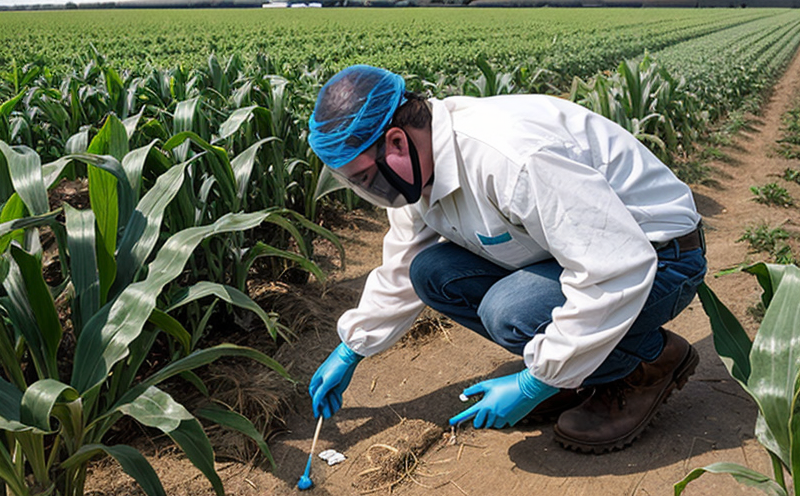Chlorpyrifos Residue Testing in Crops
The testing of chlorpyrifos residues in crops is a critical aspect of agricultural quality control and food safety. Chlorpyrifos, a widely used organophosphate insecticide, has been shown to have significant effects on both human health and the environment when present at levels above recommended limits. Regulatory bodies around the world, including the U.S. Food and Drug Administration (FDA), European Commission, and various national food safety agencies, have established maximum residue limits (MRLs) for chlorpyrifos in different crops to ensure public health protection.
Our laboratory offers precise and reliable chlorpyrifos residue testing services using advanced analytical methods that comply with international standards such as ISO 17025. Our dedicated team of experts uses state-of-the-art instruments including gas chromatography-mass spectrometry (GC-MS) to ensure accurate detection down to the lowest permissible limits specified by regulatory bodies.
The process typically involves collecting representative samples from various parts of the crop, followed by thorough extraction and cleanup procedures designed to separate chlorpyrifos residues from other compounds. Once purified, the sample is analyzed using chromatographic techniques capable of distinguishing between different forms of chlorpyrifos (e.g., parent compound vs. metabolites).
Understanding the distribution patterns of chlorpyrifos within crops is crucial for assessing potential exposure risks during harvest and processing stages. This information helps stakeholders make informed decisions about appropriate harvest times, storage conditions, and post-harvest handling practices.
- Customer Impact: Accurate identification of chlorpyrifos residues allows farmers to adjust their application practices accordingly, ensuring compliance with legal requirements while minimizing adverse impacts on soil health and nearby ecosystems. Additionally, reliable testing results enable food processors and retailers to maintain product integrity throughout supply chains.
Our commitment to excellence ensures that all tests meet or exceed the stringent quality control criteria set forth by relevant authorities, providing peace of mind for clients seeking assurance regarding their agricultural products' safety and compliance.
Why It Matters
The presence of chlorpyrifos residues in crops poses several challenges that necessitate stringent testing protocols. From an environmental standpoint, excessive use of this pesticide can lead to contamination of groundwater supplies, harming aquatic life and non-target organisms like beneficial insects. In humans, prolonged exposure to low levels of chlorpyrifos has been linked to neurodevelopmental disorders, particularly among children. Therefore, adhering to strict residue limits is vital for safeguarding public health.
Compliance with international standards such as ISO 17025 guarantees that our laboratory adheres to rigorous quality management systems, ensuring consistent and accurate results across all samples analyzed. By leveraging cutting-edge technology like GC-MS coupled with advanced sample preparation techniques, we can achieve high sensitivity levels necessary for detecting even trace amounts of chlorpyrifos.
In addition to regulatory compliance, thorough residue testing plays a pivotal role in maintaining brand reputation among consumers who increasingly demand transparency about ingredient sourcing and processing methods. For instance, companies involved in organic farming or specialty crop production must demonstrate adherence to stringent environmental standards, making reliable chlorpyrifos residue testing essential for certification purposes.
Our services also benefit researchers studying the long-term effects of pesticides on ecosystems. By providing detailed data on how chlorpyrifos accumulates within different types of crops over time, our lab contributes valuable insights into best practices for sustainable agriculture.
Quality and Reliability Assurance
To uphold the highest standards of precision and accuracy in chlorpyrifos residue testing, we employ a comprehensive quality assurance framework that encompasses multiple layers of validation. Each step from sample collection to final report generation undergoes stringent checks to minimize errors and ensure reproducibility.
Sample Preparation: Our trained personnel follow standardized procedures for selecting representative samples, ensuring they reflect the overall condition of the crop being tested. After collection, samples are preserved under controlled conditions until analysis can be conducted promptly. This minimizes degradation or contamination that might affect test outcomes.
Analytical Methodology: Utilizing GC-MS allows us to achieve exceptional sensitivity and selectivity when identifying chlorpyrifos residues in complex matrices such as fruits, vegetables, grains, or oilseeds. The method follows strict protocols outlined by international standards like ISO 17025, ensuring consistency and reliability.
Result Interpretation: Our analysts interpret results according to official guidelines provided by regulatory agencies. They also consider factors such as crop type, growing region, application history, and expected levels of contamination when determining whether detected residues exceed acceptable limits.
Our commitment extends beyond mere compliance; we strive to provide actionable insights based on our findings. For example, if high levels of chlorpyrifos are found in a particular batch of produce destined for export markets, this information can prompt corrective actions such as additional washing procedures or adjustments in application rates for future crops.
Customer Impact and Satisfaction
- Improved Product Quality: By identifying chlorpyrifos residues early in the production process, farmers can take corrective measures to prevent exceeding acceptable limits. This not only ensures compliance with regulations but also enhances product quality by reducing any potential negative impacts on taste or texture.
- Enhanced Reputation: Reliable testing results contribute significantly to maintaining a positive brand image among consumers who prioritize health and safety in their purchasing decisions.
- Cost Efficiency: Early detection of excessive residues allows for targeted interventions, avoiding costly recalls later in the supply chain. It also helps companies avoid penalties associated with non-compliance.
- Increased Market Access: Compliance with international standards opens up opportunities for exporting crops to countries or regions where strict residue limits apply.
We continuously strive to exceed customer expectations through prompt delivery of accurate reports and proactive communication throughout the testing process. Our goal is to establish long-term partnerships built on trust and mutual respect, ensuring that every client receives personalized attention tailored to their specific needs.





